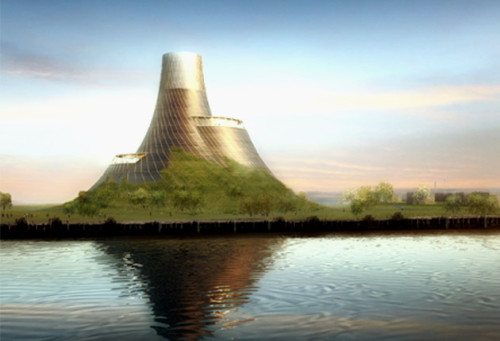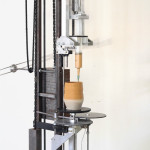“There’s currently a virtually endless supply of places you could install solar panels that DON’T have cars driving over them.” Read more at Equities and check out the comments at Slashdot.
How Biomass Energy Has Become the New Coal
“The biomass power industry is undergoing a new surge of growth in the United States. While bioenergy has traditionally been used by certain sectors such as the paper-making industry, more than 70 new wood-burning plants have been built or are underway since 2005, and another 75 proposed and in various stages of development, fueled by renewable energy subsidies and federal tax credits. In most states, biomass power is subsidized along with solar and wind as green, renewable energy, and biomass plant developers routinely tell host communities that biomass power is “clean energy.”

Promotional photo of BEI-Teesside, a planned biomass power plant in the UK. The volcanoe shape is well chosen if you consider the pollution that is produced by biomass power plants.
But this first-ever detailed analysis of the bioenergy industry reveals that the rebooted industry is still a major polluter. Comparison of permits from modern coal, biomass, and gas plants shows that a even the “cleanest” biomass plants can emit > 150% the nitrogen oxides, > 600 % the volatile organic compounds, > 190% the particulate matter, and > 125% the carbon monoxide of a coal plant per megawatt-hour, although coal produces more sulfur dioxide (SO2). Emissions from a biomass plant exceed those from a natural gas plant by more than 800% for every major pollutant.
Biomass power plants are also a danger to the climate, emitting nearly 50 percent more CO2 per megawatt generated than the next biggest carbon polluter, coal. Emissions of CO2 from biomass burning can theoretically be offset over time, but such offsets typically take decades to fully compensate for the CO2 rapidly injected into the atmosphere during plant operation.”
Read the report: Trees, Trash, and Toxics: How Biomass Energy Has Become the New Coal (PDF), Mary S. Booth, Partnership for Policy Integrity, April 2, 2014. Via biofuelwatch.
Finally: A Life Cycle Analysis of Electric Cars
“We develop and provide a transparent life cycle inventory of conventional and electric vehicles and apply our inventory to assess conventional and EVs over a range of impact categories. For all scenarios analyzed, the use phase is responsible for the majority of the global warming potential (GWP) impact, either directly through fuel combustion or indirectly during electricity production.”
Total emissions
“When powered by average European electricity, EVs are found to reduce GWP by 20% to 24% compared to gasoline ICEVs and by 10% to 14% relative to diesel internal combustion engine vehicles (ICEVs) under the base case assumption of a 150,000 km vehicle lifetime. When powered by electricity from natural gas, we estimate EVs offer a reduction in GHG emissions of 12% compared to gasoline ICEVs, and break even with diesel ICEVs. EVs powered by coal electricity are expected to cause an increase in GWP of 17% to 27% compared with diesel and gasoline ICEVs. Wind power electricity would allow electric transportation with life cycle carbon footprints as low as 106 g CO2-eq/km.”
Vehicle production: Manufacturing one electric car takes as much energy as manufacturing two conventional automobiles
“In contrast with ICEVs, almost half of an EV’s life cycle GWP is associated with its production. We estimate the GWP from EV production to be 87 to 95 grams carbon dioxide equivalent per kilometer (g CO2-eq/km), which is roughly twice the 43 g CO2-eq/km associated with ICEV production. Battery production contributes 35% to 41% of the EV production phase GWP, whereas the electric engine contributes 7% to 8%. Other powertrain components, notably inverters and the passive battery cooling system with their high aluminum content, contribute 16% to 18% of the embodied GWP of EVs.”
“Comparative Environmental Life Cycle Assessment of Conventional and Electric Vehicles“, Troy R. Hawkins, Bhawna Singh, Guillaume Majeau-Bettez, Anders Hammer Strømman, in “Journal of Industrial Ecology”, October 2012. Via the BBC and Treehugger. Picture: Trexa. Previously: The status quo of electric cars: better batteries, same range.
The Folly of Building-Integrated Wind
“The study found that predicted performance exceeded actual performance by a factor of 15 to 17. With the worst-performing systems, the electricity required to run the electronics exceeded the electricity production, so the wind turbines were net consumers of electricity”. Read.
Thanks, Brent Eubanks. Related: Small windmills put to the test / Urban Windmills harm the environment.
Miracle biofuels
“If you grow jatropha in marginal conditions, you can expect marginal yields” & “The best outcome might be to slow down the jatropha steamroller and let science sort out whether it can be grown on a mass scale in ways that
make it preferable to food-based biofuels”. Read. Related: Leave the algae alone.
High speed trains
“We would be so much better off simply fixing up and reactivating the normal-speed track system that is sitting out there rusting in the rain — and save our more grandiose visions for a later time”. Read.
Previously: How eco-friendly is a high speed train? / The age of speed / Only idiots travel by train.





